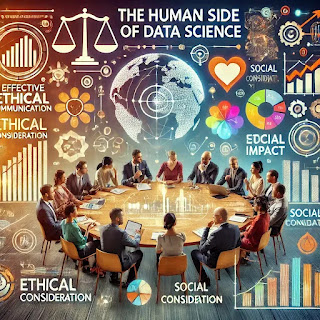Introduction: Data science is often seen through the lens of algorithms, tools, and complex analyses. However, at its core, it’s a human endeavor driven by collaboration, communication, and the shared pursuit of meaningful insights. No matter how sophisticated a model may be, its true value lies in how well it serves people and addresses real-world challenges. In this post, we’ll explore the softer yet critical aspects of data science—collaboration, communication, and the power of teamwork.
1. The Role of Collaboration: A Team Effort
Data science projects are rarely one-person shows. They typically involve cross-functional teams, including data engineers, analysts, machine learning experts, business stakeholders, and domain specialists. Each brings a unique perspective and skill set to the table. The success of any project relies heavily on how well these team members can collaborate and leverage each other’s expertise.
Example: Consider a predictive modeling project in healthcare. Collaboration between medical professionals and data scientists is crucial to ensure that models make sense in a clinical context and provide meaningful outcomes for patient care.
Takeaway: Building a supportive, respectful, and engaged team environment allows individuals to learn from each other and generate more innovative solutions.
2. The Importance of Communication Skills
Even the most groundbreaking insights or advanced models can be lost if they are poorly communicated. Data scientists must excel in translating technical results into insights that stakeholders without a technical background can understand. Clear, concise communication can be the difference between an actionable decision and an overlooked recommendation.
Example: A data scientist presenting complex findings on customer churn should avoid jargon and instead use storytelling, simple visuals, and analogies to illustrate what the data reveals about customer behavior.
Takeaway: Effective communication bridges the gap between data and decision-making. Mastering it ensures that valuable insights have a genuine impact.
3. Engaging with Ethical and Social Considerations
Data science is about more than just numbers—it impacts real people. Data scientists must be mindful of ethical considerations such as data privacy, algorithmic bias, and social impact. Engaging in open discussions with colleagues and stakeholders about these issues is crucial for building trust and ensuring responsible use of data.
Example: Algorithms used in hiring processes should be carefully vetted to avoid discrimination. This requires open collaboration with HR experts, legal advisors, and data scientists to align technical work with ethical standards.
Takeaway: Collaboration extends to ethical discussions, ensuring that data solutions serve everyone fairly and responsibly.
4. Embracing Feedback and Continuous Learning
No model is perfect, and no analysis is without gaps. Data scientists must be open to feedback, iterating on their work and learning from mistakes. Creating a culture of constructive criticism, where team members feel comfortable offering input, is essential for continuous improvement.
Example: A data scientist receiving feedback on a flawed model can see it as an opportunity to refine their approach and enhance the model’s accuracy or relevance.
Takeaway: Learning, evolving, and adapting are at the heart of effective data science. Fostering a feedback-friendly environment helps everyone grow.
Conclusion: Beyond the Code, Towards Connection
While tools, algorithms, and data are important, the human aspect of data science is what truly drives impactful outcomes. Successful data scientists are as skilled in communication and teamwork as they are in coding. By focusing on collaboration, ethical considerations, and effective communication, data scientists can make their work more meaningful and transformative.
Data science thrives when it brings people together—not just data—toward a shared goal of creating positive change.

Comments
Post a Comment